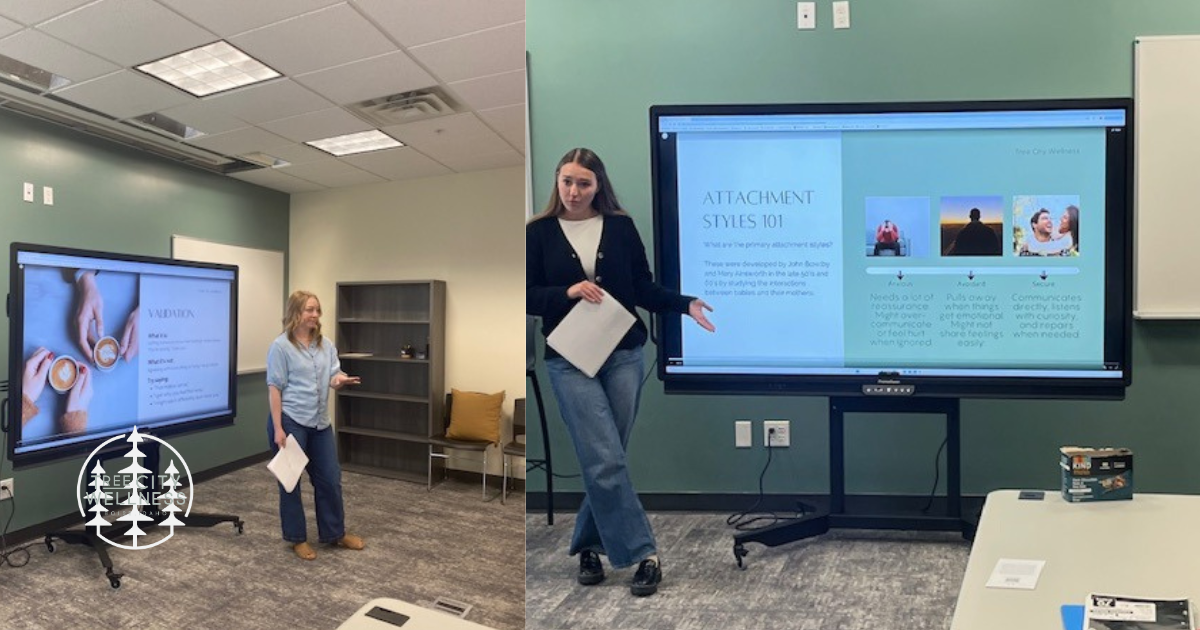If you’ve been learning about attachment styles lately, you’re not alone—and your kids are probably more interested than you think.
Recently, Madison Johnson, one of our therapists at Tree City Wellness, and I visited a high school in West Boise, Idaho, to talk with teens about healthy communication in relationships. What stood out the most? How eager they were to engage with the concept of attachment styles and how these patterns show up in their friendships, families, and early dating experiences!
Many of them already knew the basics: that anxious attachment often comes with a fear of abandonment, avoidant attachment tends to distance from emotional closeness, and secure attachment involves trust and emotional regulation. But what they wanted to know was: What can I do with this information?
Why Teens Are Talking About Attachment Styles
For teenagers, social and dating relationships are at the center of their world. Understanding attachment styles gives them a way to make sense of how they feel, react, and communicate, especially when things get hard. When teens realize they’re not “too much” or “too distant,” but rather reacting in ways they learned early in life, it creates space for reflection and healing.
We helped them explore the idea that no style is “bad” … each one is simply a strategy developed for connection. And the good news is, with awareness and practice, attachment styles can evolve over time into a more secure connection with others; whether that’s a friendship, relationship with a sibling, parent relationship, or other family or friends in their life.
Building Self-Regulation in Teen Brains
We also talked about the neuroscience of emotion. Teens are often quick to react not because they’re dramatic, but because their prefrontal cortex, the part of the brain responsible for logic and impulse control, is still developing.
We emphasized the importance of pressing pause during emotional moments. Taking a breath before responding in a heated conversation helps protect relationships and build secure communication patterns. And just as importantly, we reminded them: if you do overreact, that’s okay too. Learning to offer self-compassion after a mistake is a vital part of emotional growth and awareness.
Somatic Tools to Release Emotions
One of the most interactive parts of our workshop was introducing somatic (body-based) practices to help release built-up emotional energy. We talked about how intense emotions, like anger or frustration, can get “stuck” in the body—and when that happens, it often leads to emotional outbursts.
Cue the crowd favorite: pillow slamming. Yes, it’s exactly what it sounds like—and it works. Teens practiced slamming a pillow on the floor in a controlled, safe way to physically release emotion. Other body-based regulation tools we shared included:
- Dunking a hand in ice water (to reset the nervous system)
- Smelling a strong essential oil (like peppermint for grounding)
- Taking a brisk walk or moving the body through exercise
- Practicing deep breathing or rhythmic movement
- Even just shaking it out—like animals do after stress
All of these tools support emotional regulation, reduce reactivity, and help build secure relationship dynamics.
Why Attachment Styles Matter in Parenting
Here’s what we want every parent to know: Your kids want to talk about relationships. They’re ready to explore their own patterns, emotions, and communication habits, and they’re turning to attachment styles to help them make sense of it all.
As caregivers, when we take the time to talk openly with our kids about emotional awareness and connection, we normalize something that every human experiences. It helps them feel seen, validated, and supported. And it teaches them how to build emotionally healthy relationships from the inside out.
Need Help Starting the Conversation?
If talking about emotions or communication feels intimidating—you’re definitely not alone. That’s exactly what we’re here for.
At Tree City Wellness, our therapists work with families every day to improve communication, deepen emotional connection, and bridge the gap between parents and teens. Sometimes even just a few sessions can make a big impact—whether it’s teaching teens how to express themselves, or supporting parents in learning new ways to listen and respond.
Let’s Start the Conversation Together
Whether you’re looking for communication support, attachment education, or a safe space for your teen to explore their emotions, we’re here to help.
Let’s raise a generation that’s curious, emotionally intelligent, and empowered to form secure, healthy relationships—starting at home. Get in touch today.





